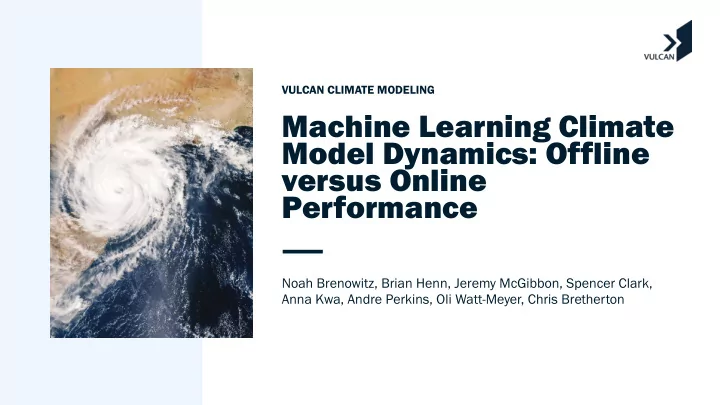

VULCAN CLIMATE MODELING Machine Learning Climate Model Dynamics: Offline versus Online Performance Noah Brenowitz, Brian Henn, Jeremy McGibbon, Spencer Clark, Anna Kwa, Andre Perkins, Oli Watt-Meyer, Chris Bretherton
Climate models help predict future changes • Numerically solves fluid mechanics equations • A longer weather simulation (w/ coupling to ocean/ice) • Many parametrizations • Discretized: • Large grid size (50 – 100 km) Image from NOAA
Climate models find local precipitation trends harder to predict than temperature WA/OR/ID average
VCM pioneers novel software to improve weather and climate models VCM = Vulcan Climate Modeling, a philanthropic, open-source project of Vulcan Inc. in Seattle (Paul Allen) https:/ ://www.v .vulcan.c .com/O /Our-Wo Work/Climate/Advancing-Cl Climate-Science.a .aspx Two interlocking groups, partnering with NOAA’s Geophysical Fluid Dynamics Lab, using next-gen version of US global weather forecast model • “Faster” (led by Oli Fuhrer): Use a domain-specific language (DSL) to rewrite the model to run faster on modern supercomputers (CPU or GPU), enabling multiyear climate simulations with 1-3 km grids • “Better” (led by Chris Bretherton): Train machine learning (ML) on these simulations to increase accuracy of rainfall predictions by an affordable 25 km-grid GCM These projects are mutually beneficial: • “Faster” gives training data for “Better”: We need fast high-resolution models to provide ML training data • “Better” gives code that runs on the GPU “Faster”: ML runs on GPUs very efficiently We are 1 year into a 2-year pilot phase, focused on the atmospheric model component, FV3GFS
Parameterizations as a machine learning problem Single Atmospheric Column • Inputs • Weather variables: Humidity, temperature, sunlight, elevation • Outputs: • Heating and moistening rates due to unresolved storms Image courtesy of the U.S. Department of Energy Atmospheric Radiation Measurement (ARM) user facility.
Literature overview Authors Training Data Evaluation Technique ML Model Krasnopalsky, et. al. (2010, 2013) Local Cloud Resolving Model Offline NN Brenowitz and Bretherton 2018, Global Cloud Resolving Model offline (2018), single column NN 2019 (GCRM), Aquaplanet model (2018), online (2019) Pritchard, Rasp, Gentine, and Super-parameterized (SP) aqua- Offline (2018) and online (2019) NN others planet Yuval and O’Gorman GCRM, aqua-planet Offline (2019) and online (2020) RF(2019), NN(2020) Han, et. al. (2020) SP, realistic topography Offline, single column model NN Mooers, et. al. (2020) SP, realistic topography Offline NN Brenowitz, et. al (2020) GCRM, realistic topography Offline, online NN and RF This presentation
Training Data • NOAA’s fine-resolution GSRM: FV3GFS/X-SHiELD • C3072 Horizontal resolution (approximately 3 km) • Resolves large thunderstorms • Nudged towards observations • Initialized at midnight (UTC) on August 1, 2016 • 40 days, saved at C384 SHiELD 40-day DYAMOND run, S.-J. Lin and Xi Chen, GFDL resolution (25 km) every 15 minutes
ML parameterizations via coarse graining Fine-resolution Coarsened Baseline Reference model Reference Model Parameterization ? ≈ Precipitation
ML Models • Random Forest • Max depth: 13 • Ensemble size: 13 • Neural Network • Multilayer perceptron • 2 layers, 128 nodes per layer • ReLU activation
Evaluation: Online ≠ Offline Offline Skill = “Traditional ML” Online = Coupled to Fluid Dynamics Input Data ML ML Fluid Dynamics Prediction Many iterations
ML Parameterization “Hierarchy of Needs” for Climate Modeling Online Low Skill Climate Bias Accurate weather forecasts Stable Simulations Offline Skill
RF and NN make similar predictions “offline” Random Forest Neural Network Net “drying” = - precipitation
Forecast Skill (online) a) Global PW RMSE model 10 Baseline NN 8 • Weather simulations initialized on RF 6 Aug. 8, 2016 at 0 UTC mm 4 • Root-mean squared error of 2 0 • Moisture (PW) Fri 05 Aug 07 Tue 09 Thu 11 Sat 13 Mon 15 time • PWSE c) Global Z500 RMSE • Random forest outperforms 120 100 baseline 80 60 m • Neural network is unstable and 40 crashes 20 0 Fri 05 Aug 07 Tue 09 Thu 11 Sat 13 Mon 15 time
Climate drifts in RF and NN b) Global Average PW 30 model Baseline NN • Global average precipitable 28 RF Verification mm water (PW) decreases in RF 26 • Too much rain! 24 Fri 05 Aug 07 Tue 09 Thu 11 Sat 13 Mon 15 • Global average 500 mb height time decreases in RF d) Global Average Z500 5,720 • Changes in circulation 5,700 • NN is more sensitive to drifts m 5,680 and crashes 5,660 Fri 05 Aug 07 Tue 09 Thu 11 Sat 13 Mon 15 time
Thanks! https://arxiv.org/abs/2011.03081
Recommend
More recommend